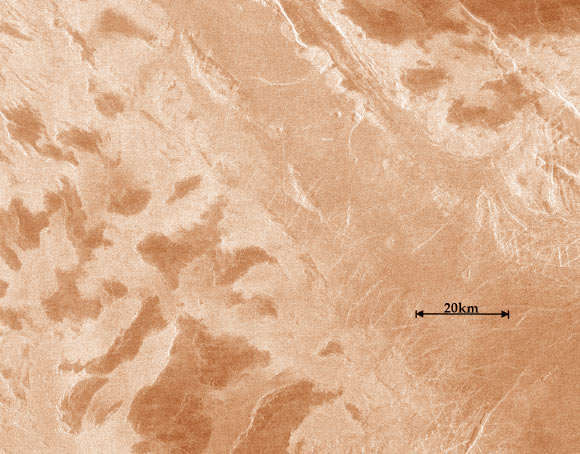According to a new analysis of twenty-year-old data from NASA’s Magellan spacecraft, mountainous regions in the Venus’ highlands are covered in an unidentified ferroelectric material.
The idea that the Venusian highlands are covered in a ‘metallic frost’ dates back to 1995, when Dr Raymond Arvidson of the Washington University’s McDonnell Center for the Space Sciences and his colleagues were analyzing the rich archives of data taken from Magellan mission.
Magellan’s primary objective was to map the surface of Venus using a technique known as synthetic aperture radar (SAR).
SAR images taken of mountainous regions in the planet’s highlands revealed a mysterious brightening effect.
Scientists surmised that this effect was due to a metal-containing ‘frost’ only a few millimeters in thickness frosting the mountains’ rugged surfaces.
Also observed were a handful of radio dark spots at the highest elevations. Both mysteries have defied explanation.
“There is general brightening upward trend in the highlands and then dark spots at the highest locations,” said Elise Harrington of Simon Fraser University, a co-author on the new study.
“Brightening, in this case, means the radio waves reflect well. Dark means the radio waves are not reflected. In other words, the higher you go on Venus, the more radio reflective the ground gets until it abruptly goes radio black. Like on Earth, the temperature changes with elevation. And the cooler temperatures at altitude lead to ice and snow, which create a similar pattern of brightening for Earth – but in visible light.”
“Among the possibilities on Venus are a temperature dependent chemical weathering process or heavy metal compound precipitating from the air – a heavy metal frost,” Ms Harrington said.
Getting to the bottom of these mysteries has been very hard because Venus has not been revisited since Magellan and no better data is available.
So Ms Harrington and her colleague, Dr Allan Trieman of Lunar and Planetary Institute, made do by re-purposing the old data.

This is a radar image of one of the areas sampled on Ovda Regio. There is a smooth ramp across the map going from higher to lower elevations, shown as a gradual transition in radar brightness up the ramp. The top of the ramp is brighter than the bottom of the ramp in the lower right corner. The bright areas to either side of the ramp are highland plateaus, and the curious dark spots are the mysterious areas at the highest elevations that the researchers are investigating. Image credit: Elise Harrington / Allan Trieman / NASA.
They used recently-available stereo radar elevation data rather than using the lower resolution radar altimetry. That increased their altimetry resolution from seeing patches 8 by 12 km to just 0.6 x 0.6 km.
They also used Magellan’s SAR, with its 75×75-m footprint, to look at radio reflectance, rather than the data on radio emissions from the surface, which had a coarser 15 by 23 km resolution.
They applied these to two areas in the Ovda Regio highlands region of Venus where they confirmed the same pattern of radar reflections brightening with increasing elevation, as was found by previous studies.
The radar reflection was low at the lower 2.4 km elevation, then rapidly brightens up to 4.5 km. But they also found a lot more of those strange black spots, with a precipitous drop in the reflections at 4.7 km.
“Our data supports the interpretation that the radar properties of Ovda could be explained by the presence of ferroelectric substance at its surface,” the scientists said.
“The identity of this compound remains elusive.”
The results were presented October 20 at the 2014 Meeting of the Geological Society of America in Vancouver.
“Dr Arvidson saw a few dark spots. But we see hundreds of them,” Ms Harrington said.
“No one knows what explains the sudden darkness. We think this might spur some more interest in Venus.”
_____
Harrington ED & Treiman AH. 2014. The puzzle of radar-bright highlands on Venus: a high-spatial resolution study in Ovda Regio. 2014 GSA Annual Meeting, paper # 136-4








